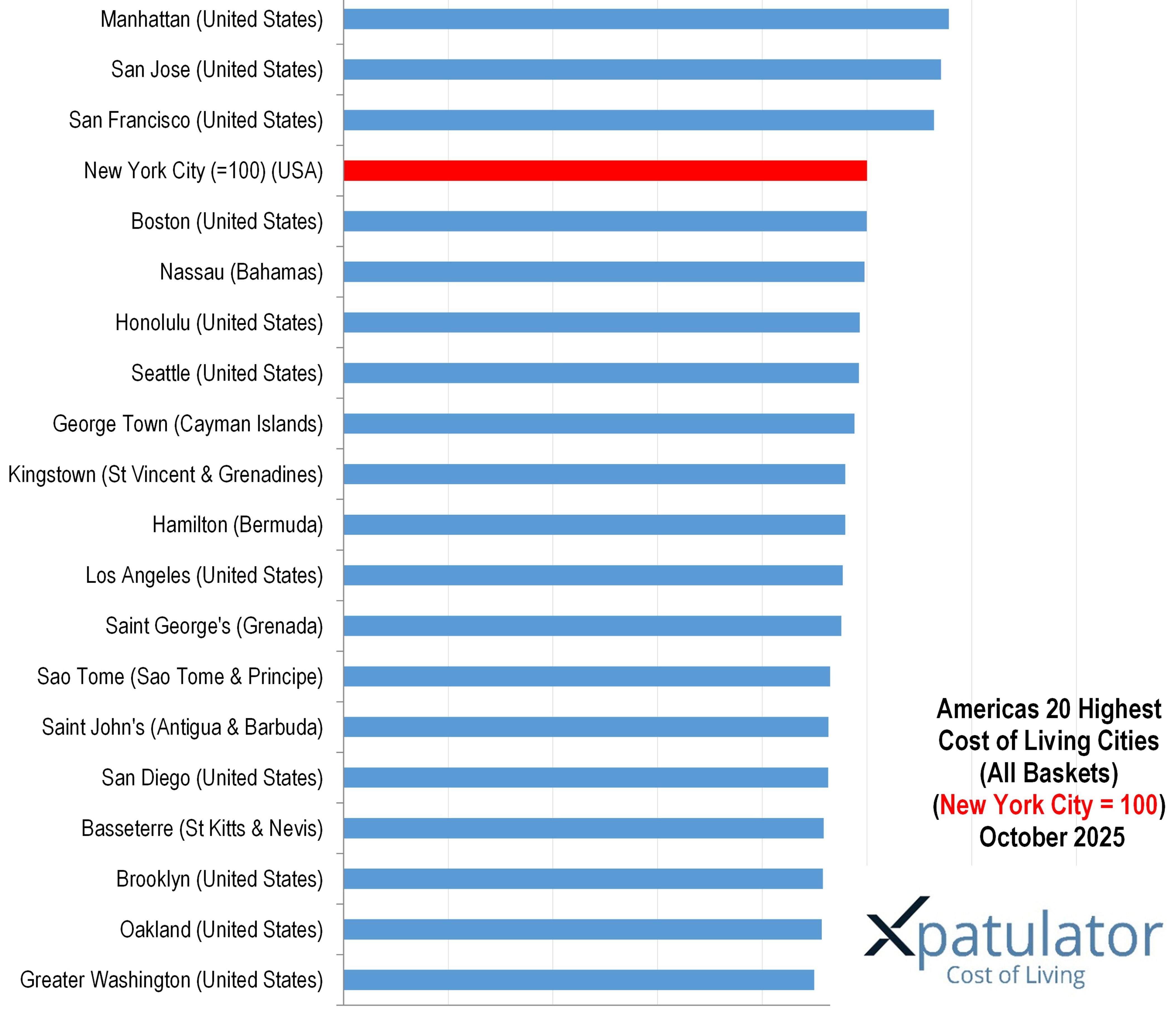
The Cost of Living: North and South America’s Most Expensive Cities in 2025
2025-10-01
The October 2025 Xpatulator survey exposes the sharp reality facing expatriates in the Americas: a region where the most expensive cities are overwhelmingly dominated by the United States and exclusive offshore enclaves. Manhattan, San Jose, and San Francisco top the rankings, reflecting the relentless rise in housing and living costs driven by tech, finance, and limited supply. Offshore centres like Nassau and George Town echo this trend, with island economies demanding a premium for imported goods and exclusivity. For expats, this means moving to these hotspots requires deep pockets and careful financial planning, as the cost of daily life in these cities can quickly erode even the most generous relocation packages, especially when compared to other regions of the world.
Expat Cost of Living in the Americas, 2025
For expatriates considering a move to the Americas, the notion of the “American Dream” is increasingly tethered to one’s bank balance. Xpatulator’s latest international cost of living survey, covering 780 global locations, starkly reveals the Americas as home to both dazzling economic opportunity and eye-watering daily expense. Using New York City as the global benchmark (index: 100), the 2025 ranking of the 20 most expensive cities in the Americas highlights urban economic disparity—dominated by the United States and the region’s offshore financial enclaves.
United States - Top 5 Most Expensive Cities in North and South America
The USA dominate the top 5 most expensive cities. Manhattan (115.6), San Jose (114.1), and San Francisco (112.8) are the top three most expensive cities. The domination of US coastal cities is neither accidental nor recent. Their gravitational pull on global talent, technology, and capital comes at a punishing cost: sky-high rents, exorbitant service charges, and consumer prices driven by both affluence and acute supply constraints. San Jose and San Francisco, the twin engines of Silicon Valley, illustrate the double-edged sword of tech-driven prosperity. Wages for top earners soar, but so too does the price of everything from coffee to childcare. For those outside the charmed circle of tech or finance, the cost of living can feel outright predatory.

New York City itself sits at the global benchmark (100), yet it is noteworthy that only Manhattan (115.6), its most prestigious and pressured borough, pushes significantly above this line. The nearby cities of Boston (99.9) and Seattle (98.4) are not far behind, their indexes buoyed by strong regional economies and chronic housing shortages. Honolulu (98.6), remote even by American standards, commands premium prices simply due to geography—virtually everything must be imported.
Offshore Price of Paradise
The list is peppered with sun-drenched offshore tax havens—Nassau (99.5), George Town (97.6), Hamilton (95.8)—where small populations, limited real estate, and import dependency drive prices relentlessly higher. These Caribbean and Atlantic enclaves are magnets for the world’s mobile elite, but also suffer from the very success they’ve engineered: exclusivity breeds high prices, especially for basics. The allure of zero income tax or banking secrecy is often offset by the cost of a pint of milk or a basket of imported groceries.
Small island capitals like Saint George’s (95.1, Grenada), Kingstown (95.8, St Vincent & Grenadines), Saint John’s (92.6, Antigua & Barbuda), and Basseterre (91.7, St Kitts & Nevis), present a similar conundrum. Expatriates relocating here for sunshine and lifestyle perks must accept a fundamental truth: paradise comes at a significant premium, particularly for those used to the shopping and service options of larger metropolises.
USA: 12 of the 20 Most Expensive Cities
What is truly remarkable, however, is the absolute dominance of the United States in this ranking. Of the top 20, a full 12 are American cities, stretching from the East Coast to the Pacific and including West Coast outposts such as Los Angeles (95.4), San Diego (92.6), Oakland (91.4), Brooklyn (91.6), and Greater Washington (89.9). Even second-tier American cities now routinely outpace the cost of living in Latin American powerhouses such as São Paulo or Mexico City—a damning indictment of the housing crisis and a triumph of the American consumer economy, depending on your perspective.
Outliers and Surprises
Sao Tome (93), the capital of the small island nation of Sao Tome & Principe, is a noteworthy outlier—its high cost index explained by its near-total reliance on imports and its isolated geography. For multinationals and NGOs placing staff here, hardship allowances are not just a formality; they are a necessity.
A Regional Perspective: Where Latin America Sits
One might expect cosmopolitan giants such as São Paulo, Buenos Aires, or Mexico City to feature more prominently. They do not. In practice, the relatively moderate cost of living in most Latin American capitals—at least in comparison to their US counterparts and offshore rivals—underscores the region’s persistent wage disparities and weaker consumer demand. For expats seeking affordability, the likes of Santiago or Lima remain bargains, though often with trade-offs in terms of infrastructure or personal security.
The Expat Equation
For globally mobile professionals, these rankings are more than academic. Housing dominates the cost equation, with rents in Manhattan and San Francisco exceeding those in many global capitals. Healthcare, schooling, and services—all at a premium—compound the challenge. An expat moving to Seattle or Boston, for instance, will face a very different financial reality than one relocating to Buenos Aires or Bogotá, regardless of headline salary.
At the same time, high cost does not always equate to high living standards for all. Income inequality, poor public transport, and social stratification are often hidden costs in the Americas’ most expensive cities. The paradox of the US is that world-beating innovation coexists with creaking infrastructure and a patchy social safety net.
Global Comparisons
Relative to other regions, the Americas’ costliest cities do not reach the Olympian heights of Monaco, Hong Kong, or Zurich—all of which comfortably outpace Manhattan. Nonetheless, for those paid in local currency, the premium demanded by the top 20 cities in the Americas can erode even the most generous expatriate package.
In Conclusion
The cost of living in the Americas, especially for expats, is clear: economic dynamism breeds expensive cities. For those with the means, the rewards are obvious. For everyone else, the price of entry is high. High levels of Reward is required to compensate for the high cost of living, in order to attract top talent.
Use Xpatulator’s Cost of Living Calculators and Tools for informed decision-making about the cost of living and the salary / allowance / assignment package required to maintain the current standard of living.